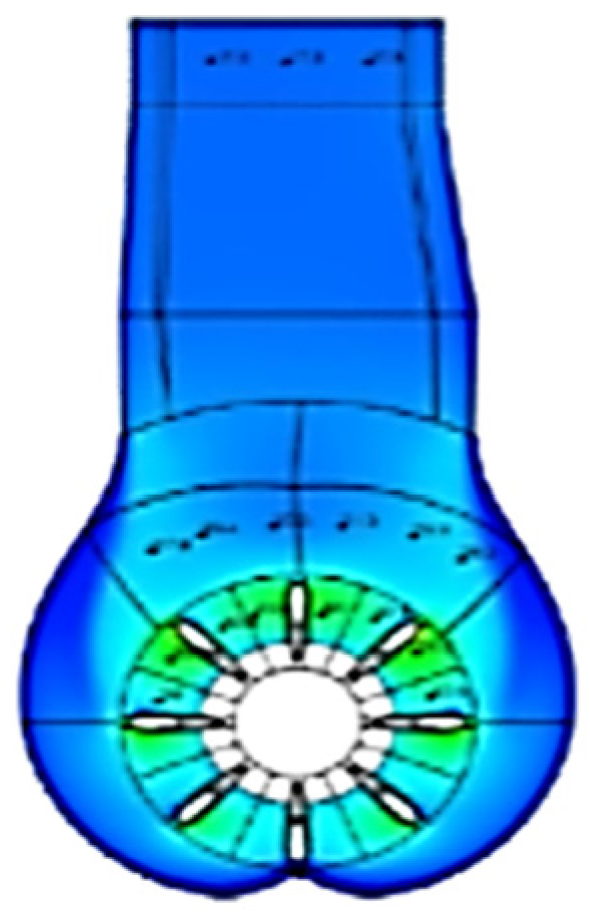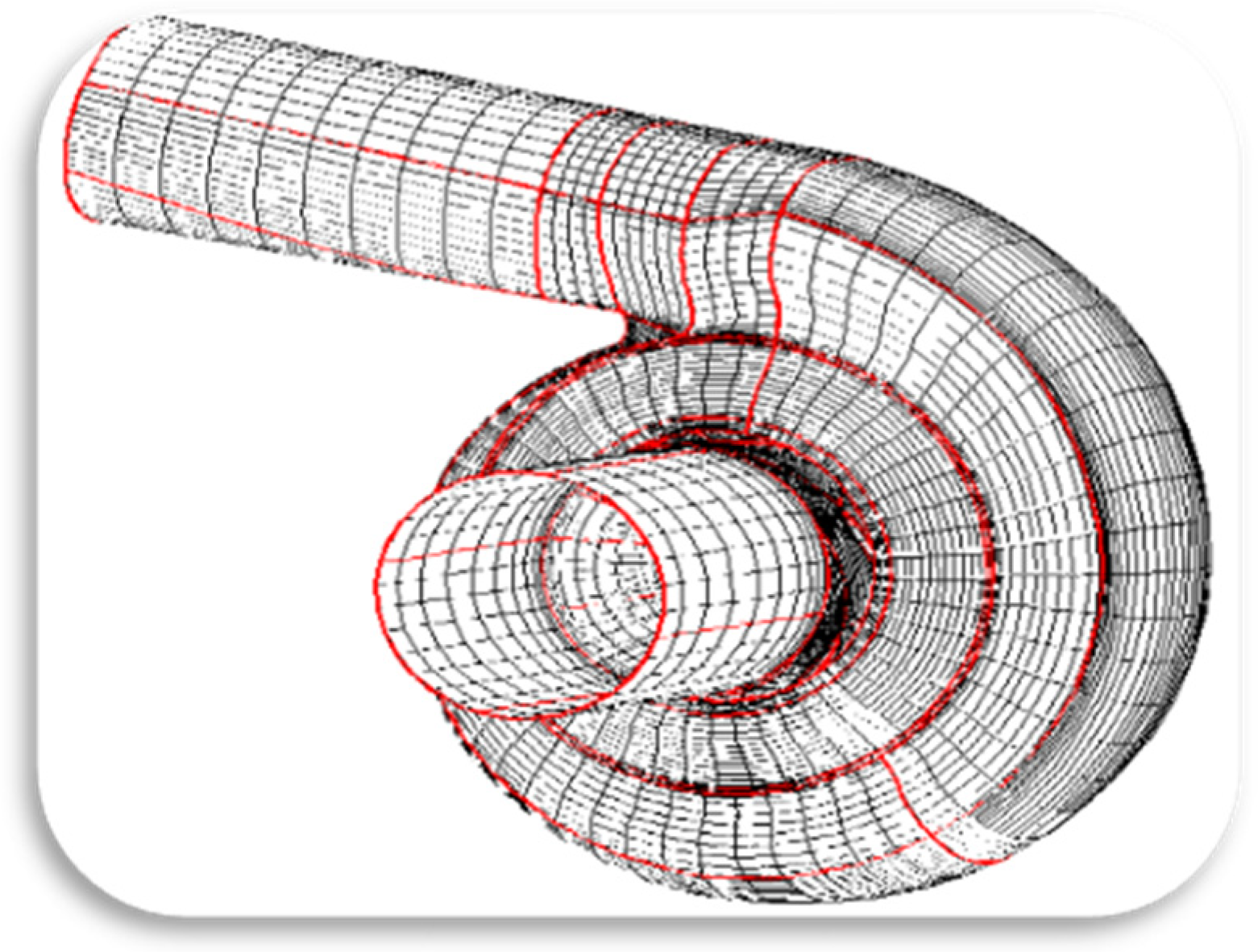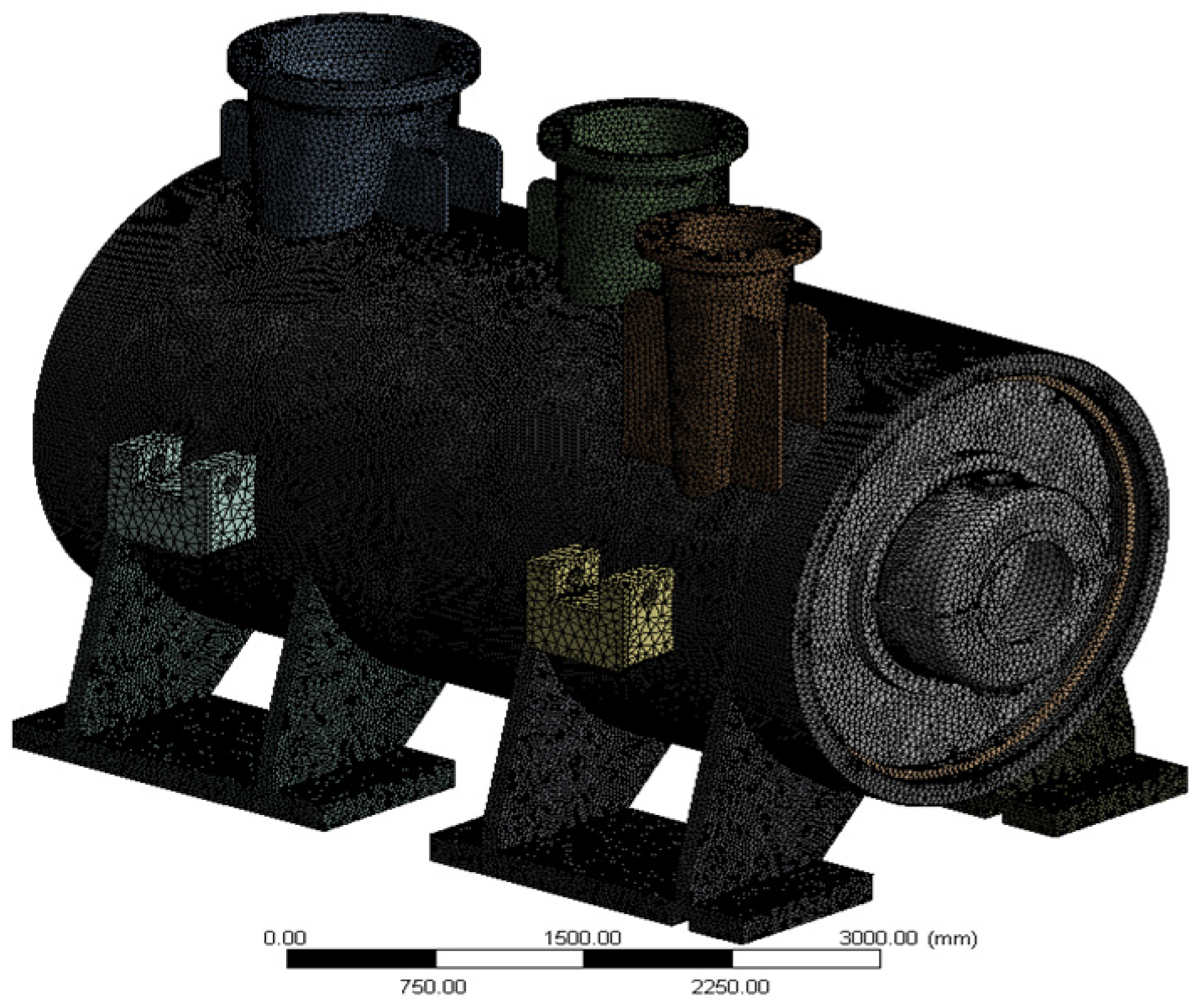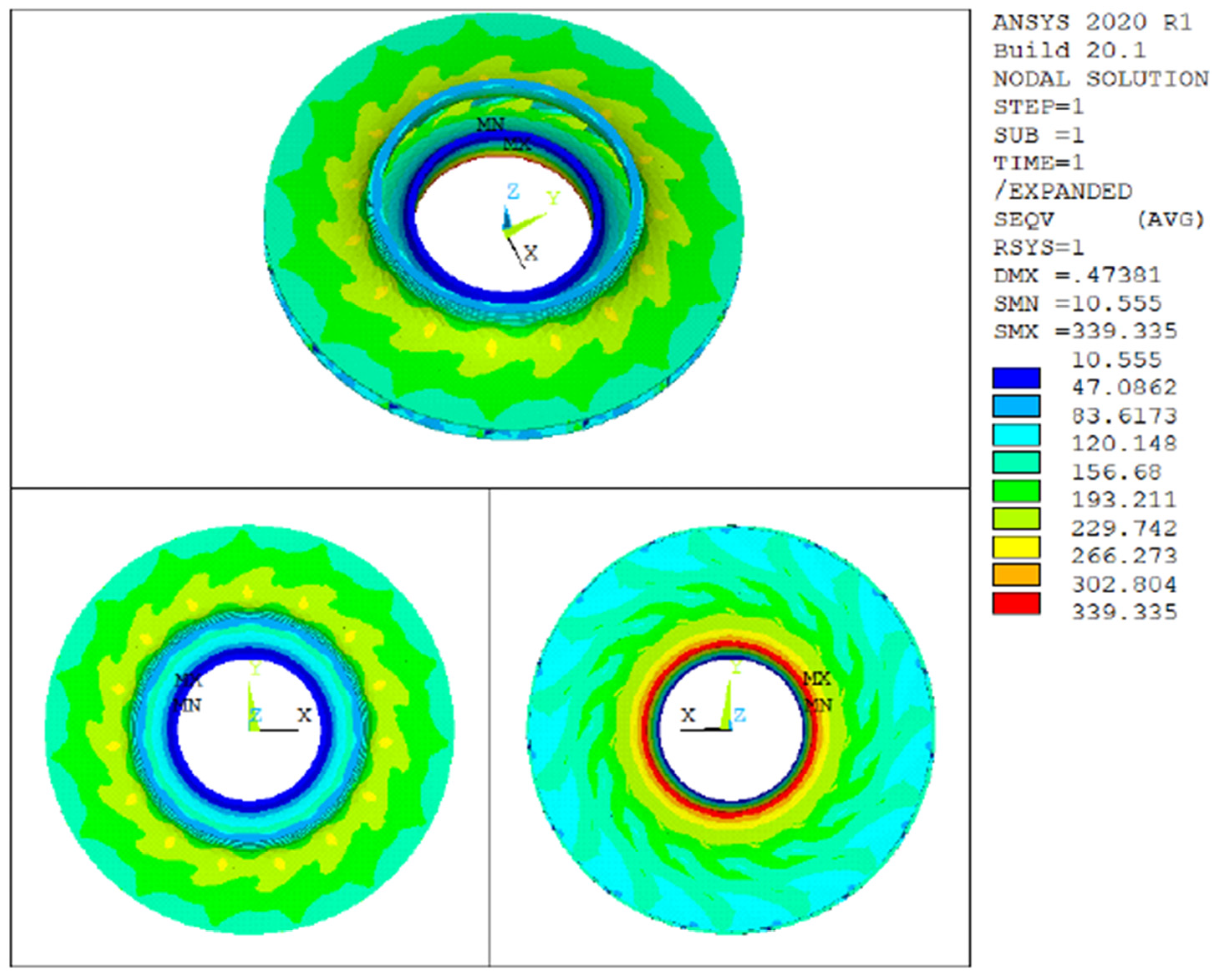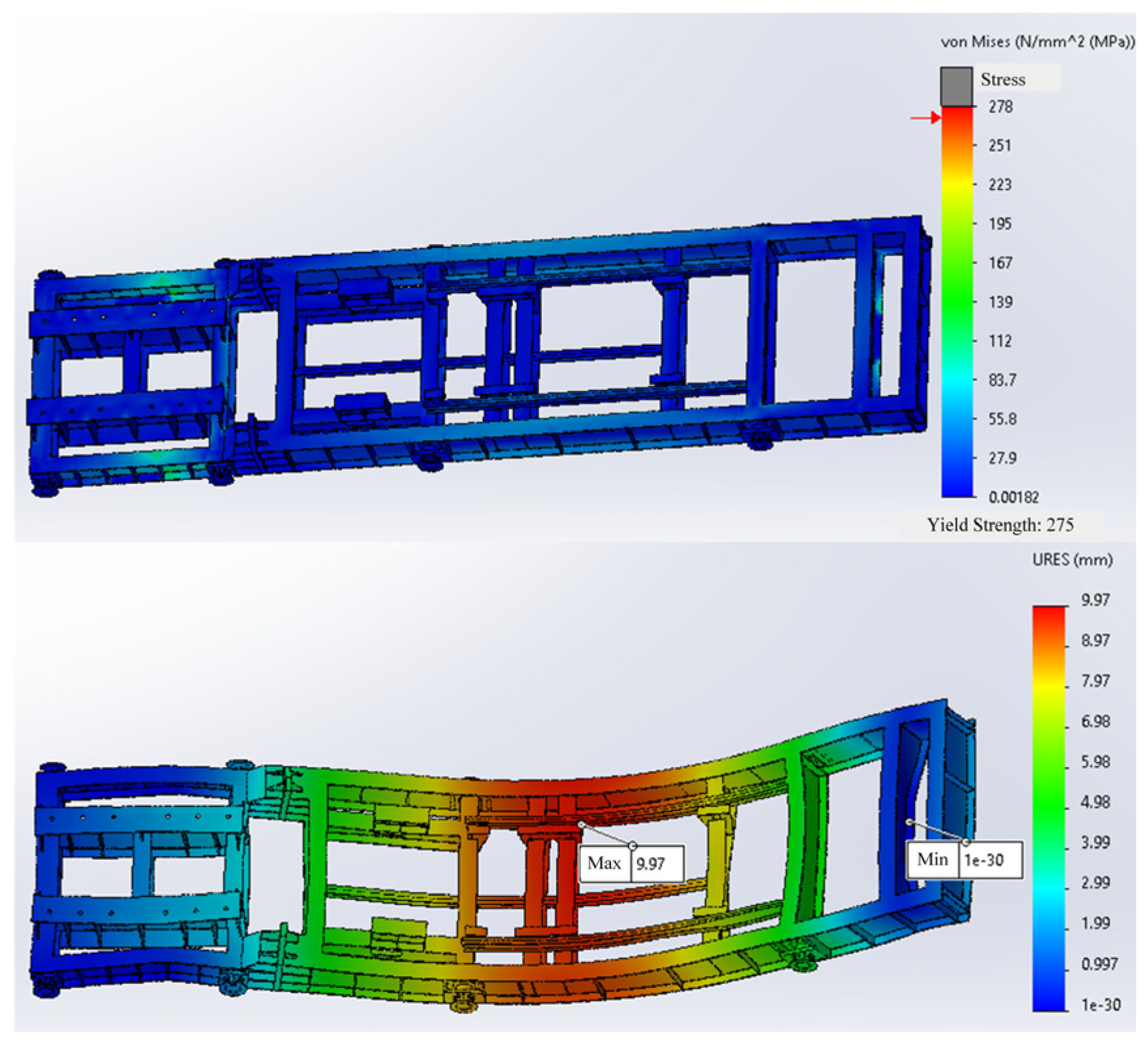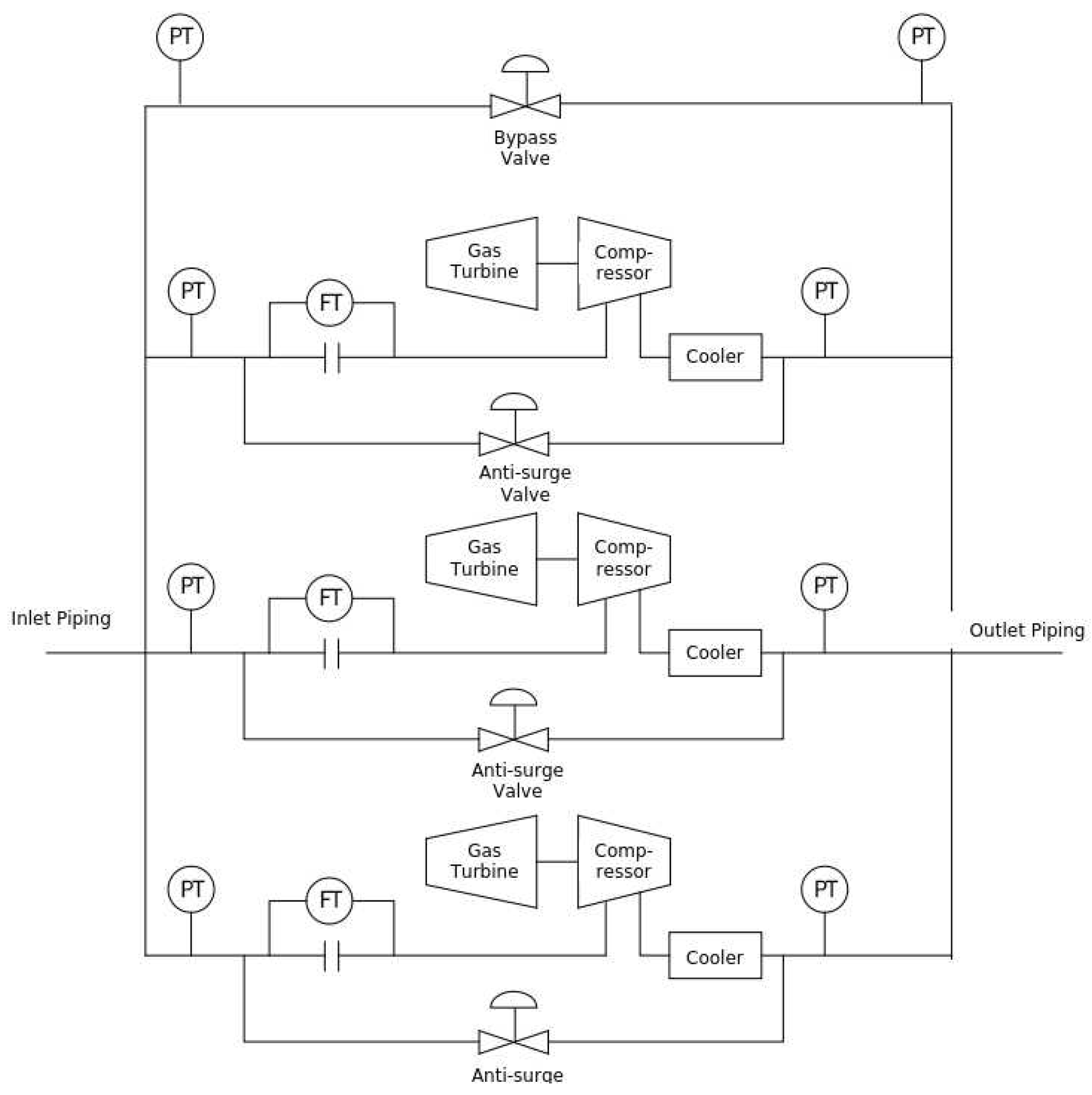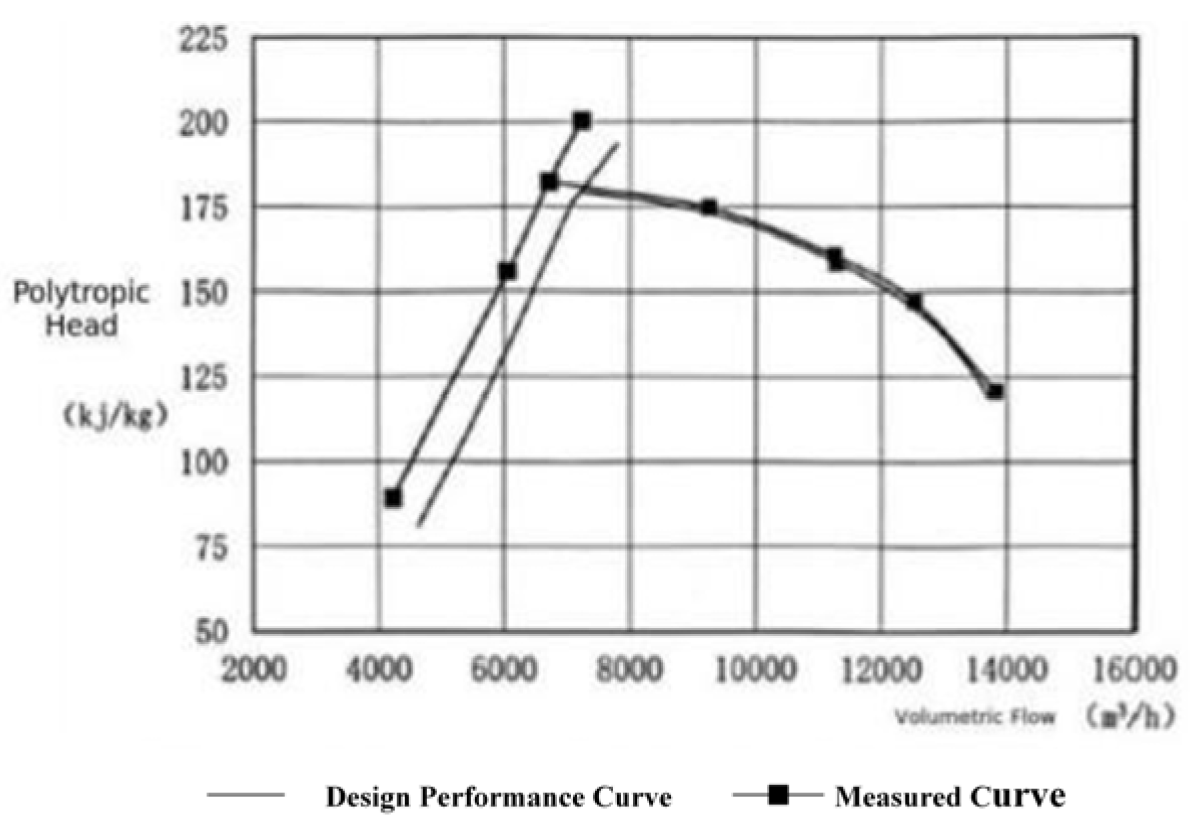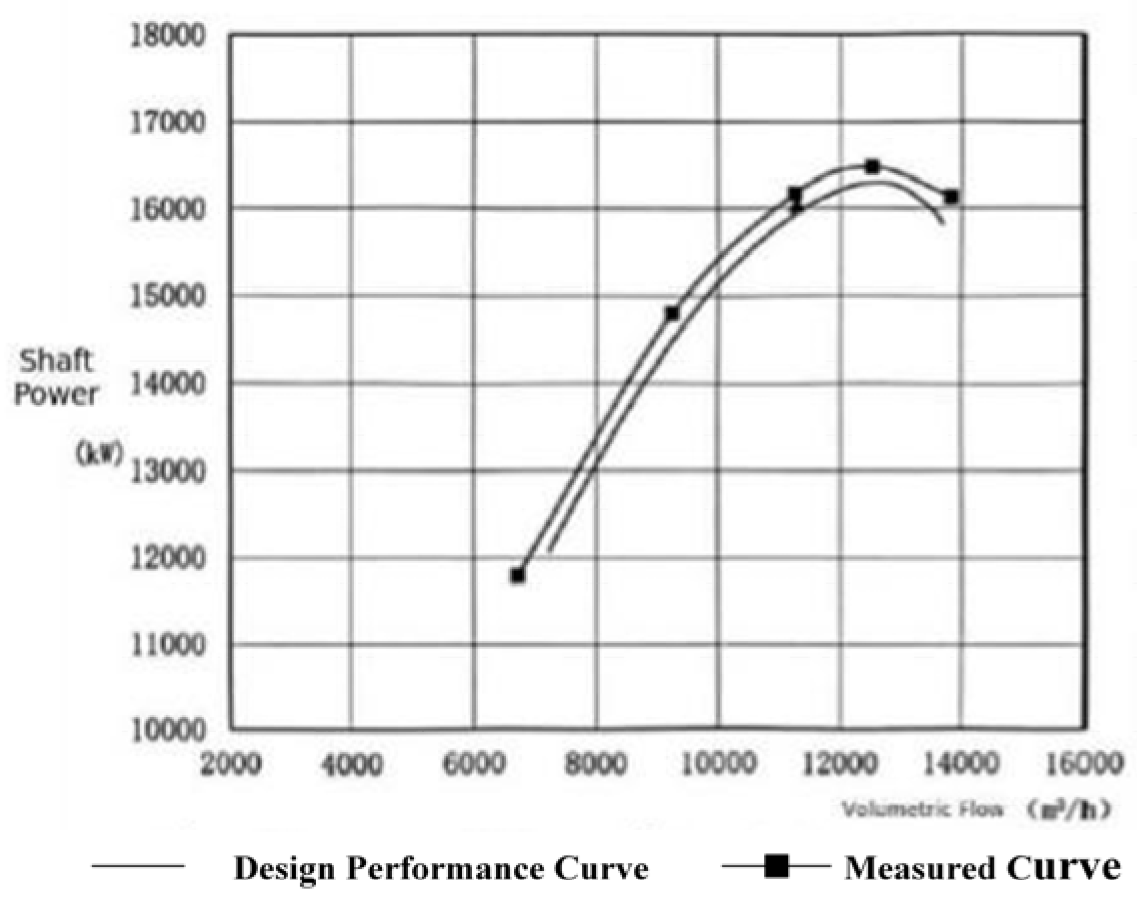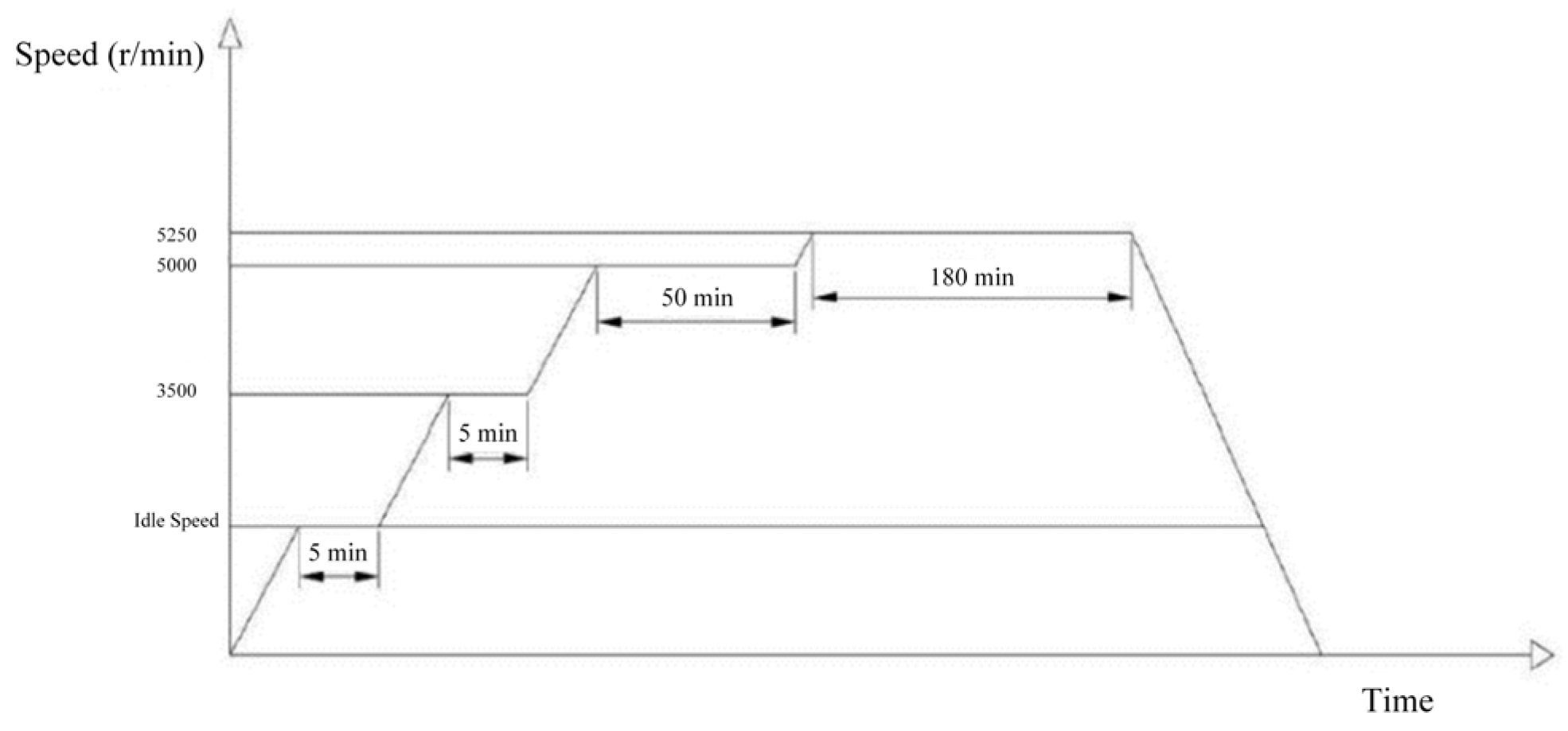1. Introduction
With the exploitation of marine oil and gas resources extending into deeper waters and more complex sea areas, offshore platforms have imposed increasingly stringent requirements on the power, efficiency, and reliability of compression equipment. As a clean energy source that plays a crucial role in China’s ongoing energy transition, natural gas must be extracted and transported from offshore platforms to onshore terminals with high efficiency and reliability. In this process, centrifugal compressor units serve as core components of gas treatment systems, and their performance directly determines the safety, stability, and economic viability of offshore natural gas development [
1,
2,
3,
4,
5,
6].
Recent studies have further highlighted the importance of improving compressor aerodynamic and structural performance under complex operating conditions. Mamari et al. conducted an integrated aerothermodynamic and rotordynamic assessment to diagnose flow degradation and deposit effects in centrifugal compressors, emphasizing the link between aerodynamic losses and rotor stability [
7]. Yahyai and Mba analyzed the rotordynamic response caused by liquid carryover in operational compressors, demonstrating how transient excitation can compromise stability and reliability [
8]. Taher and Evans developed improved computational methods for evaluating polytropic performance, providing more accurate efficiency estimation for compressor design optimization [
9]. In addition, Sutoyo et al. investigated the energy efficiency of oil and gas production systems and pointed out that compressor configuration and system layout have a significant impact on overall plant energy consumption [
10]. These studies collectively provide a solid foundation for further exploration into high-efficiency, high-stability compressor systems suited to offshore environments.
Compared with mature onshore applications, gas turbine-driven centrifugal compressor units for offshore use face multiple challenges, including difficulties in equipment selection and system integration, harsh marine environments, and elevated requirements for control system coordination and automation. The international market is currently dominated by suppliers such as GE, Siemens Energy, and Baker Hughes, who possess technological maturity and strong adaptability. However, imported units often involve long procurement cycles, high costs, heavy reliance on foreign technical services, and delayed after-sales support, which collectively restrict the high-quality development of China’s offshore oil and gas industry [
11,
12].
Against this background, and in alignment with national efforts to localize high-end equipment and establish an independent and controllable industrial chain, the development of domestically produced centrifugal compressor units with independent intellectual property rights has become both urgent and essential. The 25 MW gas turbine-driven centrifugal compressor unit presented in this study addresses several critical technical challenges, including high power rating, harsh offshore operating conditions, and the integration of advanced control systems, marking a significant milestone in the localization of offshore compression technology in China.
The motivation of this work extends beyond the pursuit of localization alone. It focuses on several key technical innovations and engineering challenges. For the large-shaft, high-pressure centrifugal compressor, the research emphasizes improvements in aerodynamic efficiency, structural reliability, and rotor dynamic stability. Considering the unique characteristics of offshore platforms, innovative structural designs have been proposed, such as a three-point anti-vibration mounting (AVM) configuration and an optimized skid base frame layout, which differ substantially from conventional onshore installations. Moreover, as this represents the first offshore application of such a high-power unit, a dedicated verification and testing program has been developed to validate its performance and reliability, providing valuable technical reference for future first-time offshore applications of similar equipment.
The unit has successfully passed type testing and on-site verification, with operational results demonstrating performance comparable to, and in some aspects exceeding, that of imported equipment. These outcomes confirm its technological maturity and market potential for wider deployment in offshore oil and gas projects [
3,
13,
14,
15,
16,
17].
This paper systematically presents the overall design of the 25 MW domestically developed gas turbine-driven centrifugal compressor unit, covering the skid-mounted base frame with vibration isolation, integrated control system, and performance verification program. Furthermore, it summarizes key engineering practices and offers development insights for localized offshore compression systems, providing both theoretical and technical references for future high-power, high-pressure, and large-flow compressor applications.
3. Optimization Design of the Centrifugal Compressor
3.1. Compressor Selection and Structural Measures
Considering the characteristics of the offshore environment and the aerodynamic requirements—specifically the large pressure ratio and wide operating flow range—a model suitable for low-speed, high-pressure-ratio operation and capable of stable low-flow operation without recycle was selected.
To meet the speed constraints, the impeller diameter was increased and the number of impeller stages was raised; the BCL808 centrifugal compressor was ultimately chosen. Structural measures include: large-diameter impellers with shortened bearing span to improve rotor stability, an enlarged balance disk to reduce axial thrust caused by the large pressure ratio, high-precision thrust bearings with good thermal performance to withstand residual axial loads, and imported dry gas seal housings to ensure sealing reliability under pressure fluctuations.
3.2. Flow-Passage Structure Optimization
Structural optimization and flow analysis were carried out for the compressor inlet volute, discharge volute, and internal flow passages through an iterative design process. The optimization did not involve major changes to the overall structural form; instead, for the large-shaft, large-casing centrifugal compressor used in this study, the transition lengths and dimensions between the inlet/outlet volutes, inlet/outlet piping, and the compressor flow passages were refined to ensure optimal flow performance. In the revised computational setup, a tetrahedral mesh was generated for the flow domain, containing approximately 2,951,312 cells, and a grid independence test was performed to ensure the reliability of the CFD results. As shown in
Figure 3 and
Figure 4, these optimizations improved flow uniformity and reduced aerodynamic losses, decreasing volute loss from 1.3% to 1.1%. The compressor’s polytropic efficiency exceeded 82%, reaching the level of comparable imported units.
3.3. Structural Reliability of the Compressor Body
To ensure long-term reliable operation under complex offshore conditions, the compressor casing is designed as a forged shell with two end covers. The end-cover assembly may use snap rings or bolts, and the casing is rated for a maximum discharge pressure of 20 MPa. The impellers are made of precipitation-hardening stainless steel to resist CO
2 and H
2S corrosion. The rotor span was shortened, stiffness increased, and bearing clearances optimized to enhance rotor stability and reduce the influence of high-pressure gas on rotor dynamics. A schematic of the compressor body is shown in
Figure 5.
Rotor stability is particularly critical for large-shaft, high-pressure centrifugal compressors, which are prone to dynamic instabilities such as critical speed resonance, oil-film whirl, and vibration amplification. In offshore applications, the supporting configuration—such as the three-point anti-vibration mounting (AVM)—further affects the rotor’s dynamic behavior, making stability evaluation essential to ensure safe and reliable operation. The rotor-dynamic simulations in this study were therefore performed for a special design case characterized by a large shaft diameter, a heavy barrel casing, and high-pressure operation, rather than for conventional mature models.
ANSYS 2021 R1 finite element analysis was employed to evaluate the static strength of the compressor casing and impellers. The mesh model, shown in
Figure 6, was generated using tetrahedral mid-node elements, with bolt holes and minor geometric details simplified to balance computational accuracy and efficiency. Under the maximum operating pressure of 18.15 MPaG, the stresses in the main pressure-bearing components were calculated as summarized in
Table 1.
The impeller material, FV520B-S, exhibited a maximum equivalent stress of 339 MPa at the maximum continuous speed, well below its yield strength of 686 MPa, confirming sufficient strength margins, as illustrated in
Figure 7.
3.4. Rotor Dynamics and Stability Analysis
Rotor dynamics analysis was performed to verify critical speeds, unbalance response, and stability. The unbalance response and spectrum are shown in
Figure 8 and
Figure 9. The first critical speed margin is 19.1% and the second is 24.1%, both meeting API 617 requirements, indicating sufficient dynamic separation.
The first-order logarithmic decrement is 0.245, and the ratio Q
0/Q
A ranges from 2.08 to 2.78, indicating stable rotor operation, as shown in
Figure 10.
5. Control System Optimization Design
5.1. Control System Architecture
The control system for the gas turbine-driven centrifugal compressor package comprises three Unit Control Systems (UCS) and one Load Share Management (LSM) system. The UCSs are responsible for unit-level detection and control functions, including start/stop sequences, process control of pressures and valves, protection/emergency shutdown/fault trips, unit-status monitoring, fire detection and firefighting control, historical data logging, and alarm management. The LSM handles station-level load distribution and bypass valve control, coordinating load sharing among units and managing bypass-line valves for the compression station [
20,
21].
The control system is designed to achieve two main objectives. First, the compressor control system, particularly the anti-surge function, is fully integrated into the gas turbine control system at both hardware and software levels to achieve a high degree of functional unification, which is necessary for compact and reliable offshore operation. Second, considering the islanded operation characteristics of offshore units, a global process recirculation control is implemented on top of each independently controlled gas turbine-driven compressor unit to enhance overall system stability and operational flexibility under offshore conditions.
5.2. Unit Control System (UCS)
As shown in
Figure 15, the UCS provides monitoring and control of the gas turbine and compressor, and also monitors/controls key process valves on the piping (inlet shut-off valve, inlet balance valve, outlet shut-off valve, outlet vent valve, anti-surge valve). Main monitored signals include inlet pressure, inlet temperature, inlet flow, outlet pressure, and outlet temperature.
The UCS functions include: gas turbine start/stop and warm-up control; turbine operation monitoring and protection (overspeed, overtemperature); compressor control and monitoring (surge protection, flow/pressure control, setpoint speed control); auxiliary systems control; alarm and trip handling; HMI; backup overspeed protection; bearing vibration and shaft displacement monitoring and protection; combustible-gas detection and firefighting control within the turbine enclosure; control and monitoring of compressor inlet/outlet isolation, balance and vent valves; anti-surge control; compressor inlet/outlet pressure control; flow control; setpoint speed control; and dry gas seal system control. As shown in
Figure 16, the UCS contains the major functional modules for turbine and compressor control and protection.
Operating modes include flow-control mode, LSM-controlled mode, inlet-pressure-control mode, outlet-pressure-control mode, automatic and manual modes. After the turbine is started and warmed up, the unit may be loaded and operated under these modes.
Hardware design, production and integration of the UCS are provided by the gas turbine OEM, covering turbine, compressor and package auxiliary hardware. The package control software is developed by the turbine OEM, while the compressor anti-surge and dry gas seal PLC programs are supplied by the compressor manufacturer (China State Shipbuilding Corporation Limited, Harbin, China). The turbine OEM integrates the control-program structure and develops the main program; the anti-surge and dry-gas-seal programs are configured as independent “tasks” with local variables to avoid conflicts with the main program. After embedding these programs into the host controller, integrated functional tests are performed.
5.3. Load Share Management (LSM) System
The LSM coordinates the operating points of the three units to maintain comparable distances from the surge/anti-surge lines. LSM functions include load distribution control, station bypass-valve control, and process control (inlet/outlet pressure and flow).
As shown in
Figure 17, the load distribution is used to coordinate and maintain a consistent distance of each unit’s operating point from the surge line/anti-surge line. The booster station bypass valve control includes high outlet pressure protection, low inlet pressure protection for the booster station, and unit anti-surge protection. Process control includes inlet pressure control, outlet pressure control, and flow control.
When three units operate in parallel, differences in compressor manufacturing tolerances, control precision, and piping result in different operating-point distances to the surge line even at the same rotor speed and anti-surge valve opening. The unit closer to the surge line is at higher risk. One LSM objective is to equalize the surge margins of all units to reduce this risk.
As illustrated in
Figure 18, the LSM anti-surge control strategy maintains unit distances from the surge line by coordinating flow setpoints and bypass-valve operations. The LSM control structure (
Figure 19) supports modes such as flow control, outlet-pressure control and inlet-pressure control. The bypass-valve control logic is shown in
Figure 20.
7. Conclusions
The 25 MW domestically developed gas turbine-driven centrifugal compressor unit has been successfully deployed and operated on an offshore platform, demonstrating high efficiency and stable performance comparable to imported equipment. The unit has achieved significant project-level benefits, including approximately 60 million CNY in cost savings per unit and a reduction in delivery time from 24 months to less than 18 months, while breaking the monopoly of foreign units and exhibiting strong market competitiveness. The main technical conclusions are as follows:
- (1)
Based on the performance requirements, an overall matching design of the compressor and gas turbine was completed. The compressor flow path and structural reliability were optimized to reduce vane losses and enhance rotor stability.
- (2)
A three-point anti-vibration mounting (AVM) support system and an optimized skid base frame were designed to meet the specific structural requirements of offshore platforms. Their reliability was validated through finite element analysis.
- (3)
To address the lack of real-time maintenance conditions during offshore operation, an integrated control system and load distribution system were implemented, enhancing operational safety and flexibility.
In summary, the design and successful application of this 25 MW domestic gas turbine-driven centrifugal compressor unit represent a major breakthrough in the localization of offshore oil and gas platform compression equipment in China. Beyond immediate project-level benefits, the offshore-specific design features—such as the three-point AVM support, supporting base frame, and specialized testing requirements—provide valuable reference for future first-time offshore applications. Furthermore, the innovation and deployment of this unit contribute to the development of related industrial chains, promoting technological autonomy and strengthening the industrial competitiveness of China’s offshore oil and gas sector. With wider application in ongoing and future offshore projects, this unit is expected to achieve broad adoption in both domestic and international markets.


